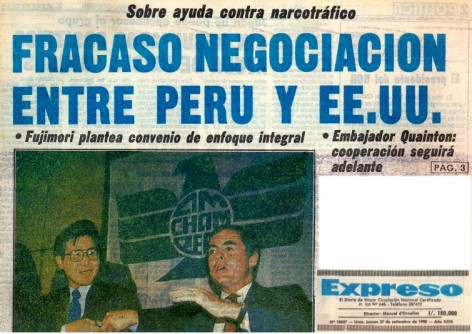On September 26, 1990, two months after assuming power, President Fujimori informed the public —and the US Ambassador— that the Peruvian government would not renew its anti-narcotics agreement with the US. At the time, there was a strong sentiment among the nation’s opinion makers that though disapproval of drug trafficking was high, Peru was being forced to fight a US war on Peruvian soil.
Peru, after all, had lived with the coca leaf for thousands of years, whereas the “War on Drugs” was a relatively recent phenomenon, driven mainly by millions of US addicts. Moreover, the President feared that indiscriminate repression against coca farmers would push them into the arms of drug traffickers and terrorist movements that were over-running the coca growing areas. According to Peruvian army estimates, repressive measures against coca growers could spawn up to 45,000 new recruits for the terrorists.
The ILD shared the President’s view but also believed that drug traffickers had to be dealt with severely and that an understanding on the issue of drugs with the international community was crucial to Peru’s goal of re-entering the global economy with the help of Western powers. The ILD had already made public its solution for reconciling these apparently contradictory objectives by making a distinction between the drug traffickers, who were illegal mafiosi and the coca growers, who were impoverished, extralegal entrepreneurs with, as a result of Peru’s archaic legal system, few economic alternatives other than growing coca. The ILD argued that if coca-growing families were welcomed into the legal system, while the drug traffickers were dealt with harshly, not only would opportunities to wean farmers away from coca-growing increase, they would also be less likely to act as an army for the traffickers —as had happened in countries such as Burma, Lebanon and Colombia. Moreover, distinguishing between the two groups would prevent a cruel, unwinnable war between the Peruvian Government and more than 200,000 coca-growing families.
To align all these objectives, the ILD designed and proposed an anti-drug policy that rested on five pillars:
-
To make a legal and political overture to the coca-growers and demonstrate to them that the Peruvian legal system was going to integrate them into the economy rather than continue marginalizing them.
-
To reform Peruvian law so that farmers were decriminalized and Government had the means necessary to offer them alternatives to growing coca, which included the titling of their land.
-
To educate the Peruvian public that fighting coca was in its own interests in order to avoid the collusion between drug traffickers and farmers.
-
To hit drug traffickers as strongly as possible.
-
To convince the US and other Western nations that Peru’s solution to drug trafficking was both credible and feasible.
President Fujimori approved the ILD proposal and presented it in his message to Congress on October 26, 1990, officially dubbing the proposal the “Fujimori Doctrine.” US authorities accepted the Peruvian position almost immediately and signed the anti-drug agreement with Peru on May 14, 1991. This agreement recognized that the coca growers were not by definition drug traffickers but extralegal producers; that the repressive strategy had to be exclusively directed against the drug traffickers; and that the best way to fight drug trafficking was to create an alliance between government and growers by way of policies that prioritized democratic participation, property rights, and alternative development measures that took into account the environment —all under the guidance of government authorities.
A month later, in June 1991, to give the whole process credibility among coca-growers, the ILD convinced UN officials to supervise and oversee the peaceful process begun by the Fujimori Doctrine. ILD personnel then fanned out across the coca areas and persuaded the coca-growing organizations to register in the program. The ILD then arranged for the leaders of Peru’s 182 coca growers associations, comprising close to a million farmers responsible for producing 90 percent of the coca in Peru, to come to Lima and meet with President Fujimori and the ILD in the President’s official residence to crystallize the new relationship between the Peruvian Government and the growers.
 In July, all the leaders were transported by two Hercules cargo transports from their jungle locations into Central Lima to meet with the President and the ILD. With extensive press coverage, the new policy earned the support of more than 85 percent of the population. A few weeks later, the President enacted a law officially recognizing the coca growing associations that had signed up and agreed to participate in a peaceful crop substitution process and in the decision-making processes related to alternative development. Finally, at a meeting at the US White House in September 1991, President George Bush made a public statement supporting the Fujimori Doctrine.
In July, all the leaders were transported by two Hercules cargo transports from their jungle locations into Central Lima to meet with the President and the ILD. With extensive press coverage, the new policy earned the support of more than 85 percent of the population. A few weeks later, the President enacted a law officially recognizing the coca growing associations that had signed up and agreed to participate in a peaceful crop substitution process and in the decision-making processes related to alternative development. Finally, at a meeting at the US White House in September 1991, President George Bush made a public statement supporting the Fujimori Doctrine.
The underpinnings of this anti-drug policy are still in place. Pacifying the farmers, winning public support, and thus neutralizing the anti-US agitators in Peru made the fight against drugs an uncontroversial crusade that allowed authorities to focus on prosecuting the nation’s drug traffickers without opposition. The result was that Peru’s anti-drug efforts are still perceived as among the most successful in the world.
In February 1992, when De Soto ended his relationship with President Fujimori, due to fundamental political differences, the collaboration of the ILD with the government on the issue of drugs ended.

